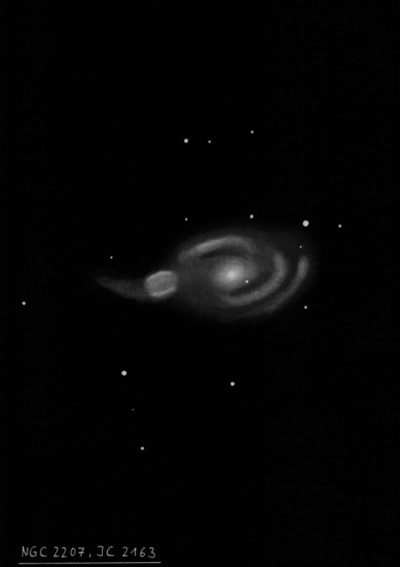
John Herschel discovered NGC 2207 = h3032 on 24 Jan 1835 and recorded "pB, pL, mE in pos = +/- 87°, pslbM, 2.5' long, 40" broad, to a tolerably well defined round nucleus." His position and Engelhardt's micrometric measurement are accurate, though I'm surprised that Herschel wasn't able to resolve the IC component of the system.
Joseph Turner observed this interacting pair on 18 Dec 1878 with the 48" Melbourne Telescope. He wrote, "It appears to consist of two nebulae" and his sketch clearly shows IC 2163 elongated E-W as a separate object to the east. He noted "the preceding one [NGC 2207] seems to have [three?] distinct nuclei or perhaps [three?] small stars." Herbert Howe also resolved the pair on on 11 Feb 1898 with the 20" refractor at Denver and was credited with the visual discovery of IC 2163. Holmberg 85b refers to the inner spiral arm (ring) to the west of the core.
300/350mm - 13.1" (1/28/84): moderately bright, moderately large, bright core, double nuclei. A faint extension is visible to the east. This is an unusual interacting pair and the extension to the east is IC 2163.
400/500mm - 18" (2/5/11): fairly bright, fairly large, sharply concentrated with a bright, elongated core (WSW-ENE) ~1' diameter and a large, much lower surface brightness halo ~2.5'x2.0'. A faint star is close WSW of the nucleus. A mag 13.5 star is at the NW edge of the halo.
Forms an interacting pair with IC 2163, which is embedded on the east side of the halo. The fainter companion appears fairly faint, moderately large, oval E-W, 1.0'x0.7', weakly concentrated
900/1200mm - 48" (2/20/12 and 2/28/19): this beautiful spiral galaxy forms a stunning pair with IC 2163 attached to its east side. The center is sharply concentrated with a brilliant nucleus embedded in a very bright core. A mag 13.5 star is superimposed on the west-southwest edge of the core. A couple of beautiful, winding spiral arms are visible in the halo. An outer arm on the south end of the galaxy stretched to the west and curved counterclockwise north towards a mag 12.5-13 star situated 1.7' NW of center. A second more inner arm vaguely emerged on the west side of the core and wrapped counterclockwise to the north, where it was parallel to the outer arm described above. This arm then curved back east along the north side of the halo, stretching to the NE side of the halo, but not reaching IC 2163. The region between the core and these arms were noticeably darker due to dust. IC 2163 is attached at the east side of NGC 2207. The central region was very bright, round, ~1' diameter, small bright core. A surprisingly prominent spiral arm is attached on the southwest side. It sweeps gracefully to the east and bends gently clockwise. This arm was ~1.5' long and significantly increased the overall size to roughly 2'x1'. Just northeast of the tip of the arm is 2MASX J06163579-2122032, which appeared as a faint, very small knot. The 2MASX galaxy is probably a dwarf elliptical at the same distance as the pair.
Notes by Steve Gottlieb